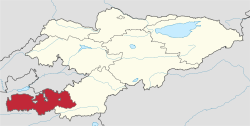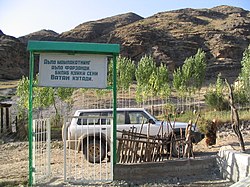Batken Region
Batken Region
Баткен облусу Batken oblusu | |
|---|---|
Region | |
 Road and field in Batken | |
 Flag  Coat of arms | |
 Map of Kyrgyzstan, location of Batken Region highlighted | |
| Coordinates: 39°50′N 71°30′E / 39.833°N 71.500°ECoordinates: 39°50′N 71°30′E / 39.833°N 71.500°E | |
| Country | |
| Capital | Batken |
| Government | |
| • Governor | Mamat Aibalayev |
| Area | |
| • Total | 17,048 km2 (6,582 sq mi) |
| Population (2020-11-01)[1] | |
| • Total | 546,400 |
| • Density | 32/km2 (83/sq mi) |
| Time zone | UTC+6 (East) |
| • Summer (DST) | UTC+6 (not observed) |
| ISO 3166 code | KG-B |
| Districts | 3 |
| Cities | 4 |
| Townships | 5 |
| Villages | 198 |
Batken Region (Kyrgyz: Баткен облусу, romanized: Batken oblusu) is a region (oblast) of Kyrgyzstan. Its capital is Batken. It is bounded on the east by Osh Region, on the south, west and north by Tajikistan, and on the northeast by Uzbekistan. The northern part of the region is part of the flat, agricultural Ferghana Valley. The land rises southward to the mountains on the southern border: the Alay Mountains in the east, and the Turkestan Range in the west.
The population of the region was reported as 380,256 by the census of 2009. Of them, 24.2 per cent lived in the region's four towns and five urban-type settlements, and 75.8 per cent in the rural areas. The majority (76.5 per cent) of the region's population are Kyrgyz; there are also Uzbeks (14.7 per cent) and Tajiks (6.9 per cent), as well as a few Russians (0.8 per cent), Tatars (0.4 per cent), and Turks (0.2 per cent).[2]
History[]
Batken Region was created on 12 October 1999, from the westernmost section of Osh Region.[3] This was partly in response to the activities of the Islamic Movement for Uzbekistan (IMU), with bases in Tajikistan. In 1999 they kidnapped a group of Japanese geologists and in 2000 some American climbers. In the two years, 49 Kyrgyz soldiers were killed. There was an attack on a Tajik border post in May 2006, which was probably connected to drug running.[citation needed] In 2021, a conflict over water rights has left 31 dead and 150 wounded on the Kyrgyz side.[4]
Socio-economics[]
- Employed population: 157,300 (2008) [5]
- Registered unemployed population: 5,499 (2008)[6]
- Export: 14.7 million US dollars (2008)[7]
- Import: 53.6 million US dollars (2008)
Demographics[]
As of 2009, Batken Region contained 4 towns, 5 urban-type settlements, and 198 villages. Its population, according to the Population and Housing Census of 2009 amounted to 380.3 thousand (enumerated de facto population) or 428.6 thousand (de jure population).[2][7] Official population estimate for 01.11.2020 was 546,400.[1]
| Year | Pop. | ±% |
|---|---|---|
| 1970 | 200,328 | — |
| 1979 | 237,469 | +18.5% |
| 1989 | 311,761 | +31.3% |
| 1999 | 382,426 | +22.7% |
| 2009 | 428,636 | +12.1% |
| Note: de jure population; Source:[2] | ||
Ethnic composition[]
According to the 2009 Census, the ethnic composition of the Batken Region (de jure population) was:[2]
| Ethnic group | Population | Proportion of Batken Region population |
|---|---|---|
| Kyrgyzs | 327,739 | 76.5% |
| Uzbeks | 63,048 | 14.7% |
| Tajiks | 29,569 | 6.9% |
| Russians | 3,560 | 0.8% |
| Tatars | 1,910 | 0.4% |
| Turks | 888 | 0.2% |
| Uygurs | 264 | 0.1% |
| other groups | 1,295 | 0.3% |
Subdivisions of Batken Region[]
Batken Region is divided administratively into 3 districts:[8]
| District | Capital | Location |
|---|---|---|
| Kadamjay District | Pülgön | East |
| Batken District | Batken | Center |
| Leilek District | Isfana | West |
There are four towns in Batken oblast: Batken, Isfana, Kyzyl-Kiya and Sulyukta. There are five urban-type settlements, including Chauvay, Khaidarkan, Sovetskiy, Kadamjay and Vostochny.
Enclaves and exclaves[]

In the Soviet period, six enclaves and exclaves were established in the Batken area. Two were Tajik, while four others are Uzbek.
Soʻx (or Sokh) (40°02′39″N 71°05′39″E / 40.04417°N 71.09417°E) is an exclave of Uzbekistan, about 24 kilometres east of Batken. The largest of the exclaves, it has an area of ~234 square kilometres, stretches from 3 to 13 kilometres from east to west, and about 35 kilometres north to south, and is crossed by the main highway from Batken to Osh. Tajiks comprise 99 per cent of the population, which in 1993 numbered 42,800.[9]
Chon-Qora and Qalacha (not to be confused with Qal'acha), immediately north of So'x, are two Uzbek villages within a very small enclave that lies on the Sokh River. It measures 2 kilometres long by 1 kilometre wide with an area of approximately 3 km2. It is part of Soʻx District of Fergana Region. The villages of Chon-Qora (or, in Kyrgyz, Chongara) at 40°15′03″N 71°02′15″E / 40.25083°N 71.03750°E and Qalacha (40°14′10″N 71°02′12″E / 40.23611°N 71.03667°E) are at either end. The Kyrgyz village of Chong-Kara (or, in Uzbek, Chon-Kara) at 40°15′37″N 71°00′41″E / 40.26028°N 71.01139°E lies 2 kilometres northwest.[10][11][12] [Note: The Kyrgyz Cyrillic alphabet contains three characters not present in the Uzbek alphabet. One of these characters is romanized from Kyrgyz as the digraph "ng," which is not present in romanized Uzbek words.][13]
Jani-Ayil (also Dzhangail, Jangy-ayyl or Khalmion) (40°12′09″N 71°39′58″E / 40.20250°N 71.66611°E) is a small exclave of Uzbekistan, about 60 kilometres east of Batken and within 1 km of the Uzbek main border. It measures only 2 to 3 kilometres across.[9]
Kayragach (40°04′05″N 69°32′41″E / 40.06806°N 69.54472°E) is a very small exclave of Tajikistan, located in the northwest corner of the region near the railway station of Stantsiya Kayragach, about 130 kilometres west of Batken.[9] The border separates it from the Tajik town of Qal'acha; hence it is sometimes called "Western Qal'acha."
Shohimardon (39°58′59″N 71°48′18″E / 39.98306°N 71.80500°E), or Shakhimardan, is an exclave of Uzbekistan, about 80 kilometres east of Batken and 19 kilometres south of the Uzbek border. It has an area of ~38.2 square kilometres, and a population in 1993 of 5,100. Uzbeks comprise 91 per cent of the population.[9]
Vorukh (39°51′04″N 70°38′00″E / 39.85111°N 70.63333°E) is an exclave of Tajikistan, with an area of ~96.7 square kilometers, located 45 kilometres south of Isfara and 24 kilometres southwest of Batken, on the right bank of the . The population, distributed among 17 villages, is estimated to be between 23,000 and 29,000, 95 per cent of which are Tajiks and 5 per cent Kyrgyz.[9]
Travel[]

The southern mountains offer excellent, but very difficult climbing with many sheer rock faces. Summits are Pyramid Peak [5,509 meters (18,074 ft)] and Pik Skalistiy [5,621 meters (18,442 ft)].
In August 2000, the Batken region received international attention after a group of climbers, including acclaimed climber Tommy Caldwell, was taken hostage by a group of rebel Uzbeks associated with the Islamic Movement of Uzbekistan whilst on an expedition in the Kara-Suu Valley. Speaking about scenery of Kara-Suu, Caldwell described the area as "unbelievably beautiful."[14]
Tourism is still relatively undeveloped in the Batken region compared to the rest of Kyrgyzstan.[15] In recent years, the government has shown interest in developing the region[16] and many foreigners have managed to visit with the help of local authorities.[17] The nearby Turkestan Range is often referred to as the "Asian Patagonia" by local trekking operators, in reference to the granite towers and the untouched wilderness that define the area.
Notable people[]
See also[]
- Iradan
- Karavshin
References[]
- ^ Jump up to: a b Population of regions, districts, towns, urban-type settlements, rural communities and villages of Kyrgyz Republic (National Statistical Committee estimate as of the beginning of 2020) 21.12.2020 / Социально-экономическое положение Кыргызской Республики в январе-ноябре 2020г.
- ^ Jump up to: a b c d Population and Housing Census 2009. Book 3 (in tables). Regions of Kyrgyzstan: Batken Region (Перепись населения и жилищного фонда Кыргызской Республики 2009. Книга 3 (в таблицах). Регионы Кыргызстана: Баткенская область (PDF), Bishkek: National Committee on Statistics, 2010, archived from the original (PDF) on 2011-08-10
- ^ Баткенская область (in Russian)
- ^ [1]
- ^ National Committee on Statistics (in Kyrgyz/Russian) Archived 2010-11-14 at the Wayback Machine
- ^ National Committee on Statistics (in Kyrgyz/Russian) Archived 2010-11-14 at the Wayback Machine
- ^ Jump up to: a b National Committee on Statistics (in Kyrgyz/Russian) Archived 2011-07-22 at the Wayback Machine
- ^ Kyrgyzstan - Джалал-Абадская область Archived August 2, 2009, at the Wayback Machine
- ^ Jump up to: a b c d e Map of Batken and Osh Regions, Goskartografiya, Bishkek, 2002
- ^ "Complete Files of Geographic Names for Geopolitical Areas from GNS". Archived from the original on 2020-04-10. Retrieved 2013-02-20.
Toponymic information is based on the Geographic Names Database, containing official standard names approved by the United States Board on Geographic Names and maintained by the National Geospatial-Intelligence Agency. More information is available at the Maps and Geodata link at http://www.nga.mil. The National Geospatial-Intelligence Agency name, initials, and seal are protected by 10 United States Code Section 425
- ^ National Geospatial-Intelligence Agency. "GeoNames WMS Viewer". Archived from the original on 2012-07-23. Retrieved 2013-02-20.
- ^ "GeoHack - Batken Province". Retrieved 2013-02-20.
- ^ National Geospatial-Intelligence Agency. "Romanization Systems and Policies". Archived from the original on 2013-02-13. Retrieved 2013-03-02.
- ^ Lowell, Josh (October 25, 2018). The Dawn Wall (Documentary). Mortimer, Peter.
- ^ Jenish, Nazgul (2017). "Tourism Sector in Kyrgyzstan: Trends and Challenges" (PDF). University of Central Asia Graduate School of Development. 42: 14.
- ^ "OSCE supports improvements to tourism infrastructure in Kyrgyzstan's Batken province". OSCE (Organization for Security and Co-operation in Europe). 2014-04-17.
- ^ Cope, Ralph (November 2019). "Trekking in Kyrgyzstan – Tips, Tricks, and Where to Start". The Broke Backpacker.
Sources[]
- Laurence Mitchell, Kyrgyzstan, Bradt Travel Guides, 2008.
- Batken Region
- Regions of Kyrgyzstan
- States and territories established in 1999
